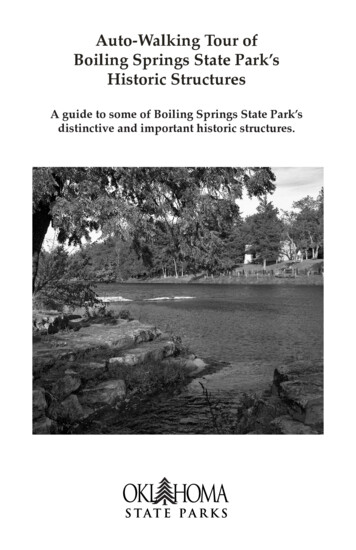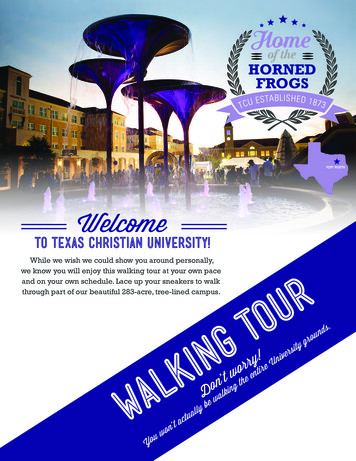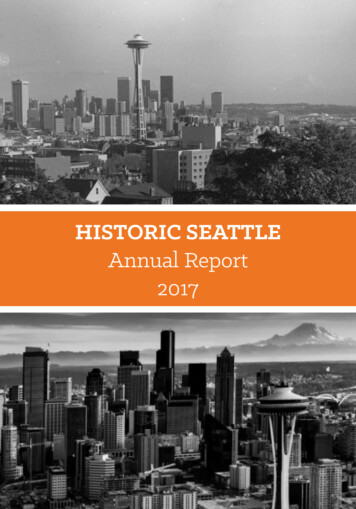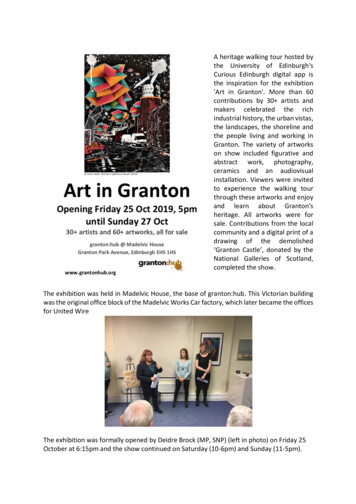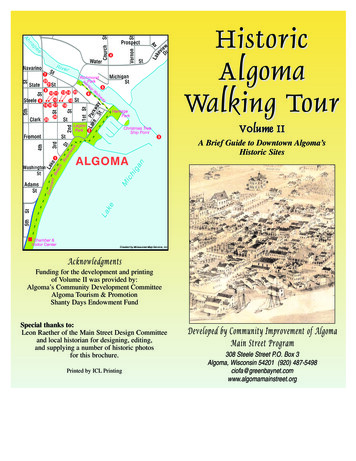
Transcription
HistoricAlgomaWalking TourV0V0 lluu mmee II IIA Brief Guide to Downtown Algoma’sHistoric SitesAcknowledgmentsFunding for the development and printingof Volume II was provided by:Algoma’s Community Development CommitteeAlgoma Tourism & PromotionShanty Days Endowment FundSpecial thanks to:Leon Raether of the Main Street Design Committeeand local historian for designing, editing,and supplying a number of historic photosfor this brochure.Printed by ICL PrintingDeveloped by Community Improvement of AlgomaMain Street Program308 Steele Street P.O. Box 3Algoma, Wisconsin 54201 (920) org
Today’s Main Street District encompasses allof the original town site of Wolf River, platted byland speculators David Youngs and George Steele in1855. With the construction of a pier and establishment of a post office in 1856, the community becameconnected with the outside world. Early merchantsbuilt stores, hotels, and livery stables to serve thegrowing farm community. Warehouses were builtdockside along the river to house goods shipped intothe town and to store lumber and farm produce awaiting shipment to Lake Michigan ports. Immediatelyfollowing the Civil War, the formerly Yankee villagewitnesses the arrival of large numbers of German,Bohemian, and Belgian settlers. Until the arrival ofthe railroad in 1891, the town grew slowly. However,the railroad brought an unprecedented boom in business, industrial, and residential development.Manufactured products, farm produce, and fresh fishcould be shipped quickly and cheaply.St. Agnes Church c. 19001. St. Agnes EpiscopalChurchSt. Agnes was organized in 1877 as Grace EpiscopalChurch. The original structure was constructed in 1878using plans prepared by Richard Upjohn, renownedarchitect of New York City’s Trinity Church,(K) Reinhart Brothers Shoe StoreProject Leading Artist: David PetriSponsored by The Reinhart Family
Wall Street. That first church was destroyed by fire inMarch of 1884. The present building, an exact copy ofthe first, was built in 1891. The interior, carefullyrestored, is noteworthy for its abundance of beautifuloak woodwork, outstanding statuary carved by artisansfrom Oberammergau, Germany, and colorful Victorianstained glass windows.(I) Ahnapee BreweryProject Leading Artist: Nancy Bennett-Centerville, IASponsored by Jag Outdoor AdvertisingVan Camp Packing Company c. 19062. The Algoma Dug-Out(J) KodanFeed Mill(Ghost Sign)Project LeadingArtist: Adam& Sarah MayLincoln ILSponsored byTom Dallman &Cheri LongThe Algoma Packing Company was organized on thissite in 1899. Originally the factory, warehouse, andoffices covered over 20,000 square feet. In the early1900’s the complex was owned by the Van CampPacking Co. of Indiana. By the end of World War I, thecompany had gone out of business. Gradually the sitewas redeveloped for use by the American Legion andthe City of Algoma. Known in the community as the“Dug-Out,” the complex continues to serve as a recreational center and is home to the Algoma GoldenAgers and Algoma Youth Club.3. Algoma LighthouseThe earliest Algoma lighthouse was built in 1892. Theupper portion of today’s cylindrical tower was constructed in 1908 when the original lighthouse wasremodeled. The lighthouse in its present form dates to1932. A popular subject for photographers, the lighthouse has come to be the symbol of the community.
(F) Algoma Net CompanyProject Leading Artist: Michael Clark-Aledo, ILSponsored by Baylake BankAlgoma Pierhead Light early 1900s(G) Kohlbeck & Sons Fine TailorsProject Leading Artist: Cameron Bortz-Pawcatuck, CTSponsored by The Norb Kohlbeck Family(H) Commercial Fishing & ShippingSt. Mary’s Catholic Church c. 1907Project Leading Artist: Dale Knaak-Sheboygan, WISponsored by Friends of Algoma
4. St. Mary’s Catholic Church(C) Ahnapee & Western RailroadProject Leading Artist: Bill & Jane Diaz, Pontiac, ILSponsored by Algoma Hardwoods, Inc.(D) Hennemann’s Cream City HouseProject Leading Artist: Dave & Susie Butler-Syracuse, INSponsored by Isaksen Architects, LLCSt. Mary’s Parish was organized by German andBohemian immigrants in 1860. The present building,constructed according to plans prepared by Green Bayarchitect, G. W. Reynolds, was completed in 1906. It isthe third church to stand on this site. The building, withits handsome steeple, prominently sited on a hill, canbe seen for miles around and is listed on LakeMichigan navigational maps. The eight carved stonelions at the base of the steeple were the work of Frenchstone cutter Simeon Navarre. Three magnificent woodaltars, designed and carved by Father Adalbert Cipininthe 1880’s for a previous building, continue to grace theinterior of the church.Art Dettmann Shanty c. 19405. Art Dettmann ShantyConstructed in 1935, the Art Dettmann fish shanty is anoriginal example of the type of structures built by commercial fishermen in the 1920’s and 30’s. This buildingis now listed on the National Registry of HistoricPlaces.6. Ahnapee Brewery(E) Commemorative FenceProject Leading Artist: Mike Meyer-Mazeppa, MNSponsored by WS Packaging GroupThis building was constructed in 1868 to serve as theAhnapee Brewery. After the brewery closed in the1890’s, the structure at various times served as awarehouse, fly net factory, gas-powered washingmaching factory, and feed storage facility. Dr. CharlesStiehl restored the building in 1967 for use as a
winery. Von Stiehl Winery has been owned by theSchmiling family since 1981.(A) Algoma Sport FishingAhnapee Brewery in 1876Project Leading Artist: Andy Goretski-Tomahawk, WISponsored by Algoma Area Chamber of CommerceAhnapee Manufacturing in 1899.7. Ahnapee ManufacturingNow known as the Netto Palazzo, this three-story structure was built in 1891 as a furniture factory. From 1921to 1980, the Algoma Net Company occupied the building. Originally this firm produced fly nets for horses. In1993, Community Improvement of Algoma procuredthe long-vacant building in order to turn it over to adeveloper for restoration and adaptation into shop space.(B) Orange Crush (Ghost Sign)Project Leading Artist: Bernie Gietl-Carlinville, ILSponsored by Algoma Optimist Club
In 2007, the Algoma Main Street Program continuedits historic preservation efforts in the downtown byorganizing the incorporation of ten historic murals,which included two ghost sign restorations, one panelinstall and seven direct applications to brick buildingfacades.The artwork design and creation of the murals wasaccomplished through the efforts of a group of international artists known as the Walldogs, under thedirection of local Walldog artist Dave Petri. These“keepers of the craft” contribute their time and talentsto preserving the one-time prevalent means of advertising signage applied directly to buildings.Algoma is proud to showcase the results of this effort,while further supporting the historical awarenessdepicted in the murals and the artisans of old throughthe purveyors of this unique craft. Watch for additional murals as the project continues to develop.8. St. Paul’s Lutheran ChurchOrganized in 1863 as the First Evangelical German St.Paul’s Church, the congregation has owned this site atFourth and State Streets since 1869. The presentchurch, designed by Boston architect C.C. Buck, wasbuilt in 1896. The Cream City brick, of which it is constructed, was hand-molded and fired at the brickyard ofthe parishoner, Ferdinand Storm. The tower clock wasinstalled in 1902. The interior of the church retains theoriginal altar, pulpit, and distinctive bentwood pews, allmade locally by the Ahnapee Seating and VeneerCompany. Also noteworthy are the Victorian stainedglass windows.WALLDOG WAVE PROJECT AREAJIGFH KD CB AESt. Paul’s Church c. 1906
9. Lidral and Andre HardwareThis handsome late-Victorian store building was builtin 1902 by business partners Frank Lidral and IsadoreAndre. It served as a hardware store until 1920. Overthe years it has been a plumbing shop, Western Autostore, a bank, floor covering shop, home décor store,auto parts shop and computer store.Gerhart Building, 1891-190523. Gerhart BuildingThis pair of commercial buildings dates back to 1891and 1905 by John Cepek. The building on the cornerfirst served as a tavern and later as an implement shop,hardware store, photo shop, and antique shop. The1905 section was built to be a hardware store. This twobuilding complex was known for many years asGerhart’s Hardware.Lidral and Andre Hardware in 190310. Wilbur BuildingBuilt in 1881, this building served as a drug store until the1950s; the second floor was a photo studio from 1891 to1936. From the 50’s to the 70’s, Lindy’s, an ice cream parlor, magazine and newspaper shop, operated here.M.W. Perry House, 190924. M.W. Perry HouseWilbur Building: Fluck’s Drugstore 1917Local industrialist Melvin Perry built this impressivehouse as his residence in 1909. Designed by Appletonbased architect W.W. De Long, the interior decor incorporated materials produced by Perry’s firm, AlgomaSeating and Veneer, to showcase the company’s productline to potential clients. Sadly neglected for many years,the house has recently been carefully restored and is nowa bed and breakfast.
11. Reinhart BuildingMathias Reinhart and Mathias Melchior built thisstructure in 1879. The Reinhart family operated a shoestore here until 1983. Another owner continued thebusiness until 1991.Braun Implement, c. 187021. Braun ImplementMerchant Sam Perry first built a frame livery stable onthis site in 1870. Sometime in the late 1880s, the structure was greatly enlarged and finished with a brickexterior. The Braun family, long-time owners of theproperty, operated a Case implement dealership herefor many years.Reinhart Shoe Store c. 1910Clark Residence, 188522. William Clark ResidenceThis brick Victorian Italianate-style house, distinctivefor its bracketed eaves, round topped windows andornate bay window, was built by Paul Gablowsky in1885. The present owner bought the house in the 1990sand has worked over the years to bring the house backto its former elegance.12. Perry BuildingIrish-born Samuel Perry built this structure to house hisgeneral mercantile business in 1886. At the time, it wasthe largest such business in Kewaunee County. Thefamily operated the business until 1910, when thebuilding was sold to become an early Ford dealership.From 1936 to 1942, it was the home of AlgomaMotors, a GM and Pontiac dealership. Still later, itbecame a Ford and Mercury dealership. In 1990, it wasrenovated to serve as office space and renamedRichmond Center.
Perry Mercantile Company c. 1890The Wisconsin House c. 189013. Bank of AlgomaCompleted in 1914, this neo-classical building was thehome of the Bank of Algoma. This institution mergedwith the Citizen’s Bank in 1933 at the height of theGreat Depression. The Algoma City Hall occupied thebuilding from the mid-1930’s until 1974. The upperfloor was home to the Algoma Public Library at various times between 1921 and 1974. The interior retainsmuch of its original marble detailing.20. Kirchmann HotelWilliam Bastar built the first portion of this structure in1870. In 1880, a 1,944 square foot addition was builtwith additional hotel rooms and a second floor dancehall. Fred Kirchmann bought the hotel in 1903, and thebuilding remained in the family until 1969, serving asa hotel and boarding house.Kirchmann Hotel c. 1900Bank of Algoma 1914
The Kohlbeck Clothing Store c. 191014. Kohlbeck BuildingBusch and Cohn Building c. 190618. Busch and Cohn BuildingDesigned by Green Bay architect G.W. Reynolds, thishandsome commercial block was built in 1905 forJulius Buschand Michel Cohn. Especially impressiveis the neo-renaissance gable at the center of the façade.This building has housed a furniture store, saloon,funeral parlor, music store, men’s clothing shop, clinic, doctors’ offices, and a church office over the years.Professional suites originally occupied the secondfloor, eventually giving way to apartments.19. Wisconsin HouseFrom the time of its construction in 1875 until 1905,this building served as a hotel. It was first known as theWisconsin House, later as Hotel Algoma and HotelMartin. For many years the main storefront housed adrugstore. A grocery and dry goods store once occupied the 4th Street storefront.The Kohlbeck Building was constructed in 1884 tohouse the tailor shop established in 1876 by FrankKohlbeck. In 1907, the business expanded into the former bank building immediately to the east. The business remained in the Kohlbeck family for five generations, closing in 2001. The building at the right of thephoto was built in 1878 by Michael Melchior andserved as the community’s first bank. From the latenineteenth century through the mid-twentieth century,this building housed the Ahnapee Record and theAlgoma Record-Herald newspapers.
15. Hotel StebbinsThe Hotel Stebbins was originally built by CaptainCharles Fellows in 1858 and named the AhnapeeHouse. In 1905, the three-story brick portion of thebuilding was constructed, and the original woodenstructure was moved to the northern edge of the lotwhere it still serves as the hotel’s kitchen and diningroom. At that time the name was changed to HotelStebbins in honor of DeWayne Stebbins, early pioneerand state senator.16. Henry Baumann andMichael Melchior BuildingsHenry Baumann built the first modest frame false-frontstructure at 222 Steele Street in 1878. Over the years ithas served as a butcher shop, harness shop, and furniture store. Since 1956, it has been the home ofHarmann Studios. The brick structure on the cornerwas built in 1894 by Michael Melchior to house hisshoe store. The other storefront was originally a drygoods store.Hotel Stebbins c. 1906Mathias Melchior Building c. 190017. Mathias Melchior BuildingThis attractive Queen Anne style building was constructed by Mathias Melchior in 1894. Over the years,many businesses found their homes here including adry goods store, the post office, law and dentist offices,and jewelry store. Since 1967, the corner shop hashoused a florist business.The Baumann (I.) and Melchior (r.) Buildings c. 1900
in 1902 by business partners Frank Lidral and Isadore Andre. It served as a hardware store until 1920. Over the years it has been a plumbing shop, Western Auto store, a bank, floor covering shop, home décor store, auto parts shop and computer store. Built in 1881, this building served as a drug store until the

